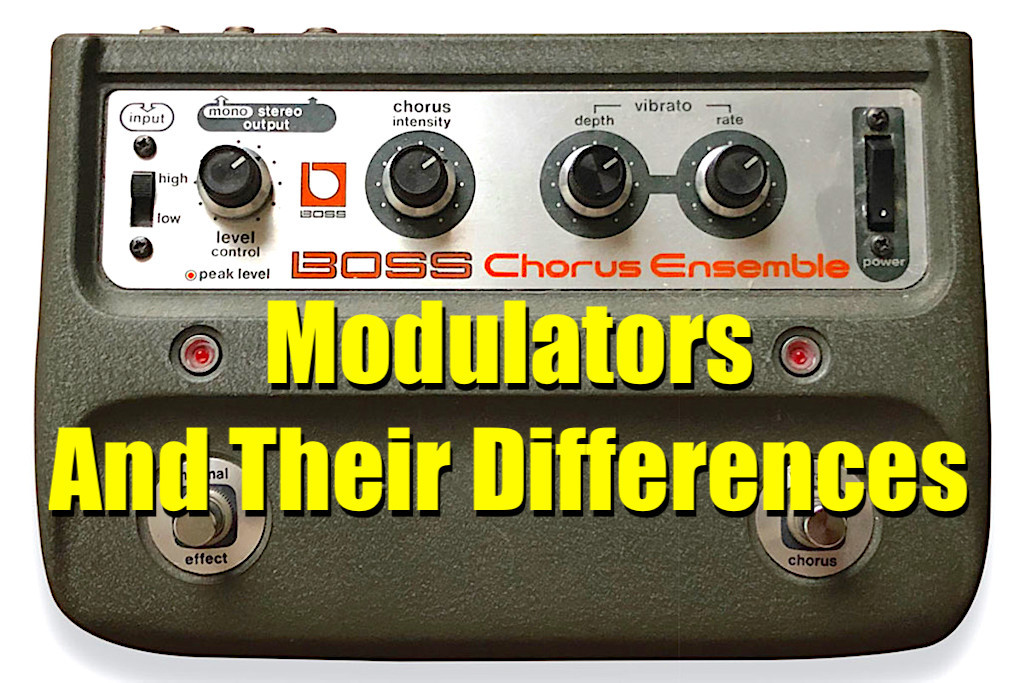- in Production by Bobby Owsinski
A Look At Modulation effects And Their Differences

Modulation refers to an external signal that varies the sound of an instrument or vocal in volume, timing or pitch. This includes effects like chorus, flanging and phasing, which are pretty standard mixing tools, to tremolo and vibrato, which are used mostly on guitars, synths and electric pianos.
Between reverb, delay and modulation, modulation is the least used mixing effect because a little goes a long way. And except for flanging, you’ll also hear modulation effects used mostly on a single track at a time, instead of across the entire mix. In fact, most modulation effects are inserted directly in the signal path of a channel instead of using a dedicated send and return configuration.
Modulation Basics
While all modulation effects certainly don’t sound the same, not many mixers know the real differences between them. Let’s take a look.
There are three modulation effects that are very closely related; phase shift, chorus, and flange. The simplest difference between them is that a chorus and flange effect comes from a modulated delay that’s mixed back into the original signal. The flanger uses a shorter delay than a chorus, usually much less than 5 milliseconds, but a phaser uses no delay at all (see the table below).
Going a bit deeper, flangers, phasers and choruses work by producing a series of frequency bandwidth notches that are slowly swept across the frequency spectrum of the instrument or vocal. You don’t really hear these notches; you hear what’s left in the frequency spectrum, which is a series of peaks. Phasers have a small number of notches spaced evenly across the frequency spectrum while flangers and choruses have a larger number that are spaced harmonically.
Tremolo and vibrato work a little differently because no delay is involved. Tremolo cyclically varies the signal up and down in level, while vibrato varies the tone cyclically up and down.
| Effect | Delay | Description |
| Phase Shift | None | Cancels different frequencies to create the effect. Frequency notches spaced evenly across the guitar frequency response. |
| Flanging | Less than 1ms to 5ms | Deepest depth have the greatest frequency cancellations. Frequency notches are spaced harmonically across the instrument’s frequency response. |
| Chorus | 5 to 25ms | Almost sounds like doubling while widening the sound. Used to thicken the sound and create a stereo image. Frequency notches are spaced harmonically across the instrument’s frequency response. |
| Tremelo | None | Cyclicly changes the volume. Used mostly on guitars. |
| Vibrato | None | Cyclicly changes the frequency response. |
Flangers And Phasers
The flanger is a dramatic effect that was first derived in the 60s by playback of a song on two tape recorders at the same time, and slowing one down by placing your finger on the tape flange, hence the name “flanging†(a term said to have been originated by John Lennon). One of the first hit songs that it was used on was a 1967 hit by the British group The Small Faces called “Itchycoo Park.†which featured a large dose of the effect at the end of the song. As these things usually go, once the song became a hit, every artist and producer wanted the effect on their song after that. The problem was that setting up the two tape recorders needed for the effect was both expensive and very time consuming, so it wasn’t long before an electronic simulation of sorts soon came on the market.
Back in the 70’s before the introduction of inexpensive digital delay electronics, an analog phaser was the only way to get any sort of modulated effect, but it was a weak comparison to intensity of a deep flange, which is why phasing isn’t used much – it’s just not that dramatic an effect.
Once digital delays came on the market it became possible to simulate true tape flanging, and now just about every modulation plug-in and stomp box does a great job.
Chorus
Chorus differs from flanging in a couple of aspects; the delay needed to achieve the effect is longer, and the frequency notches aren’t random like in flanging. You can thank Roland and their Jazz Chorus line of guitar amplifiers introduced in 1980 for starting the chorus craze, which was soon included across their line of keyboards as the world became hooked on the effect. Soon after the amp received such a great response, Roland introduced a version in their Boss line of stomp boxes that engineers used to easily add the effect wherever needed during a mix.
Indeed, it’s very easy to fall in love with the sound of a chorus because it’s lush sounding, and if used in stereo, can really widen the sound of a track quite a bit. If you listen to many hits from the 80s, you’ll hear the effect used, used and used some more.
Today, most modulation plug-ins allow you to select between chorus, phasing and flanging, since they’re all related.
Tremolo And Vibrato
A tremolo is a cyclic variation in volume, like what you find on Fender amplifiers (even though it’s incorrectly labeled as “Vibratoâ€). Don’t confuse tremolo with vibrato because they’re different. Vibrato changes the pitch of the sound while tremolo changes the volume.
While tremolo is occasionally used on a guitar or electric piano (both the original Rhodes and Wurlitzer electronic pianos had it built in), vibrato is rarely used since the variation in pitch can make tuning with other musicians an issue.
As said before, these modulation effects are used as much as other types of effects, but they can be a useful part of any mix.
You can read more from The Mixing Engineer’s Handbook and my other books on the excerpt section of bobbyowsinski.com.
